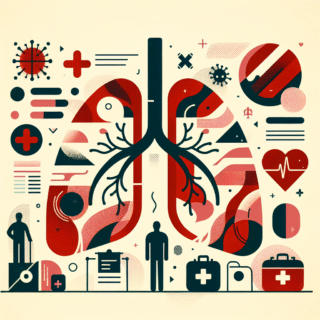
Your Health Magazine
4201 Northview Drive
Suite #102
Bowie, MD 20716
301-805-6805

More Allergy, Asthma & Infectious Disease Articles
Diseases Which Affect Your Lungs

Lung health is central to energy, exercise capacity and overall wellbeing. When a disease affect lungs, symptoms can range from mild shortness of breath to life-threatening respiratory failure. Understanding which conditions damage breathing, how to prevent them, warning signs that need prompt attention, and sensible next steps can help you protect your lungs and seek care early.
How diseases can affect your lungs
The lungs are delicate organs that can be harmed by infection, chronic inflammation, toxins and immune reactions. Some illnesses primarily target the airways and alveoli (the small air sacs), while others cause scarring or obstruct airflow. This section explains mechanisms so you can recognize patterns: infections like pneumonia fill air spaces with fluid; asthma causes airway narrowing and spasms; chronic conditions such as COPD create long-term airflow limitation; and interstitial lung diseases produce fibrosis that reduces oxygen exchange.
Common diseases that affect lungs: an overview
Here are several categories of diseases that affect the lungs, with examples you may hear about in clinical settings:
- Infectious diseases: pneumonia, tuberculosis, viral lower respiratory infections.
- Obstructive conditions: asthma and chronic obstructive pulmonary disease (COPD), including emphysema and chronic bronchitis.
- Restrictive and interstitial lung diseases: idiopathic pulmonary fibrosis and connective tissue–related interstitial lung disease.
- Allergic and hypersensitivity disorders: allergic asthma and hypersensitivity pneumonitis.
- Environmental and occupational lung disease: silicosis, asbestosis, and chemical inhalation injuries.
- Pulmonary vascular disorders: pulmonary embolism and pulmonary hypertension.
Which conditions should concern you most?
People often ask, “what diseases affect the lungs that I should watch for?” The answer depends on your risk factors: smokers and former smokers are at higher risk for COPD and lung cancer; immunocompromised people are more vulnerable to severe infections; workers exposed to dust or fibers face occupational lung disease. Persistent cough, unexplained weight loss, or blood in sputum are especially concerning and should prompt medical evaluation.
Prevention strategies to protect respiratory health
Many causes of lung damage are preventable. Key steps include smoking cessation, reducing exposure to occupational dusts and indoor pollutants, following vaccination recommendations (such as influenza and pneumococcal vaccines when advised), and practicing good hand hygiene to lower infection risk. If you have allergies or asthma, trigger avoidance and adherence to controller medications reduce exacerbations. For more on how food-related sensitivities can interact with allergic and respiratory conditions, see this article on food sensitivities and respiratory symptoms.
Regular physical activity and maintaining a healthy weight also support lung function and help clear secretions. When working around inhalants, use appropriate respiratory protection and follow workplace safety rules.
Red flags: when to seek immediate care
Some symptoms require urgent evaluation. Seek immediate care if you experience sudden or severe shortness of breath, chest pain that could be cardiac in origin, cyanosis (blue lips or face), high fever with rapid breathing, or coughing up large amounts of blood. For gradual but progressive signs—worsening cough, increasing breathlessness on exertion, or recurrent respiratory infections—make a prompt appointment with your primary care provider or a pulmonologist.
Next steps: diagnosis and treatment basics
Diagnosis usually begins with a clinical history and physical exam, followed by tests such as chest X-rays, CT scans, pulmonary function tests, and sputum cultures. Treatment varies by cause: antibiotics for bacterial pneumonia, inhaled bronchodilators and steroids for asthma and COPD exacerbations, anticoagulation for pulmonary embolism, and disease-modifying therapies or oxygen for chronic interstitial diseases. Pulmonary rehabilitation and smoking cessation programs are practical interventions that improve outcomes across many lung diseases.
For a broader overview of respiratory disease categories and background information, this reputable reference explains mechanisms and common conditions in more detail: Respiratory disease — overview.
- Take active steps: quit smoking, vaccinate, and reduce pollutant exposure.
- Know the red flags: sudden severe breathlessness, chest pain, or coughing blood requires urgent care.
- Get evaluated early: persistent cough or declining exercise tolerance deserves medical review.
- Use prescribed therapies: adherence to inhalers and pulmonary rehab improves quality of life.
Q: How can I tell if a cough is a sign of a serious lung problem?
A cough that is new and persistent (more than 3 weeks), associated with weight loss, night sweats, blood, or progressive shortness of breath should be evaluated. Acute severe changes—like sudden breathlessness or chest pain—warrant immediate medical attention.
Q: Are all lung diseases permanent?
Not always. Some infections and asthma attacks are reversible with proper treatment. Chronic conditions like COPD and pulmonary fibrosis may be long-term but can often be managed to slow progression and improve symptoms. Early detection and lifestyle changes can make a big difference.
Other Articles You May Find of Interest...
- Recognizing the Hidden Signs of a Silent Asthma Attack
- Is Dupixent the Key to Managing Your Asthma Effectively?
- Effective Strategies to Overcome PPP Disease and Regain Your Health
- Uncovering the Triggers of Pericarditis and How to Manage Its Impact
- Do Ticks Jump or Climb? Unraveling the Truth About Tick Behavior
- What Does Purulent Mean and How Does It Impact Your Health?
- Common Diseases That Affect Lung Health and Their Impact














